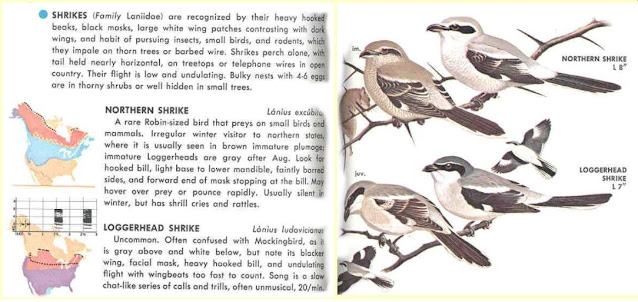 |
| #2842 "Northern Shrike" 18x14 oils on stretched canvas |
This is another image taken by my friend, John Verburg, a naturalist and terrific photographer. John provides a tremendous source of inspiration during the winter when the windchill encourages me to stay within the Singleton Studio. These striking birds are rarely seen but look for solitary and wary robin-sized birds perched at the top of a lone tree in an open field, watching for prey.
The burly, bull-headed Northern Shrike is a pint-sized predator of birds, small mammals, and insects. A bold black mask and stout, hooked bill heighten the impression of danger in these fierce predators. They breed in far northern North America and come as far south as the northern U.S. for winter. They hunt in brushy, semiopen habitats, chasing after birds, creeping through dense brush to ambush prey, or pouncing on mice. They often save food for later by impaling it on thorns or barbed wire.
Loggerhead Shrikes have a thicker black mask than Northern Shrikes that often extends over the eye and above the bill. They have cleaner white underparts without the fine barring of Northern Shrikes.There was an Environment Canada (EC) pamphlet produced during the era of "program reviews" (aka budget cuts/career losses) in the 1990s. A northern shrike was featured prominently on the cover. The EC directors probably never realized that the "butcher bird" was an editorial comment on what was transpiring within the public service.
There was a forty-year window of opportunity to take real measures on climate change beginning in the 1970s. The threats to the environment were apparent and not just dire warnings found in 200-year-old science literature. Sadly, the response to the climate and environmental crisis by governments and corporations became increasingly clear during my career. Maybe someone still has a copy of that pamphlet...
In particular, the 1990s was a time of cuts at all levels of government. Just when the efforts to address climate change and unsustainable extraction should have been escalating. The window of opportunity to take meaningful steps was still open but the cuts to science and service were brutal. The superficial and ineffective deeds did not match the heroic, political rhetoric.
Provincially, a series of"sharp" budget cuts to the Ontario Ministry of the Environment in the 1990s saw the lifetime efforts of many scientists that I personally knew and called friends, simply thrown in the dumpster outside their cubicle. https://www.jstor.org/stable/3552259
Federally, the cuts also started in the 1990s. The cuts to environmental services spoke volumes and those who were eligible to "retire early", simply left taking decades of knowledge and experience with them. Those assaults on science have never stopped.
A March 19, 2014 article bannered as "Echoes of Walkerton in Environment Canada cuts" follows with "Health and safety of Canadians is at risk with latest slashing of Environment Canada budget."
"Albert Einstein's well-known definition of insanity as "doing the same thing over and over again and expecting different results" is unsettlingly relevant to a new round of federal government cuts. The latest slashing of Environment Canada, which by 2016 will have half the budget it had in 2007, calls to mind a series of deep cuts to environmental protections in Ontario in the late 1990s. Some of the players are even the same, so they cannot reasonably claim to be ignorant of the tragic consequences.Both at the provincial and federal levels. Not much has changed."
Chapter 20 of John Vaillant's fine book "Fire Weather" summarizes the science, corporate greed and pitiful, pandering politicians seeking profit and power. The hypocritical deeds of those in control closed the window of climate change opportunity. Vailllant's 25 pages accurately cover the back story of what I described above.
The planet is almost a quarter of the way into the Century of Fire and the threshold of "OnePointFive-Celsius" - perhaps even achievable in 2024. Meanwhile, Canada charges full steam ahead in the Petrocene racing Russia to be recognized as the worst climate laggards within the environmental community.
The cost of these actions is becoming painfully clear as current record-warm weather integrates into the record-warm climate. The planet is entering a whole new climate and weather world with atmospheric carbon levels that have not been seen in more than 3 million years ago, during the Mid-Pliocene Warm Period.
I was still thinking of the birds of prey and the countless other species that call this portion of the Frontenac Arch Biosphere home as I painted. There are between 1,500 and 3,000 feathers in general on small songbirds. Art can keep me very busy but there is still time to get out and see real nature every day in the Singleton Sanctuary.
For this and much more art, click on Pixels or go straight to the Collections. Here is the new Wet Paint 2024 Collection.
Warmest regards and keep your paddle in the water,
Phil Chadwick







No comments:
Post a Comment